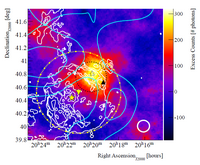
Reference: J. Aleksic et al. (The MAGIC and VERITAS Collaborations and others), Astronomy & Astrophysics 578: A22, 2015
Full text version
ArXiv: ArXiV:1412.3576
Contacts: Amy Furniss
The broadband spectral energy distribution of the TeV blazar Mrk421 was observed for 13 consecutive days from radio to very high energy gamma-rays with MAGIC, VERITAS, Whipple, FermiLAT, MAXI, RXTE, Swift, GASP-WEBT, and several optical and radio telescopes, during an multi-instrument campaign in 2010. The flux variability, which was remarkable in the X-ray and VHE bands while it was minor or not significant in the other bands, was associated to variations in the underlying particle population within two distinct leptonic scenarios, a one-zone synchrotron self-Compton (SSC) model, and a two-zone SSC model, where one zone is responsible for the quiescent emission while the other smaller zone (spatially separated from the first one) contributes to the daily-variable emission occurring in X-rays and VHE gamma-rays. This observation suggests that the particle acceleration and cooling mechanism producing the radiating particles could be the main one responsible for the broadband flux variations during the flaring episodes in
blazars.

